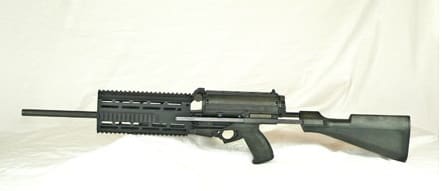“We’re currently working with the ATF to make sure the gun doesn’t fall afoul of the laws against producing a ‘destructive device.'” Isn’t that always the way? You build something that does what it’s supposed to do better than anyone else and the world (i.e. the government) puts a barrier to the path to your door. I mean, what’s a shotgun for, exactly? If you can design a weapon that overcomes the main inherent disadvantage of a fully legal and time tested weapon with, say, a helical feed device on top and a spent shell catcher beneath, why not? Still, Calico Light Weapon Systems’ Owner and President Chris Holmgren knows all about the perils of building a better ballistic mousetrap.
The 43-year-old gunsmith and toolmaker bought Calico in 2005 for probably not a whole hell of a lot of money. Calico—makers of funky automatic and semi-automatic guns with 50 or 100 bullet magazines—has been something of a problem child right from the git-go. When Mike Miller and Warren Stockton invented the M-100, back in 1985, the top loader was “ahead of its time.” In other words, the vast majority of gun buyers who saw the beast had a WTF moment and bought something, anything else. And then Calico got its clocked cleaned by the 1984 – 2005 Assault Weapons ban.
“One of the things I hear all the time,” Holmgren says. “‘Are you guys still in business?'” They sure are. And they may be about to enjoy the success they deserve. After all, who wouldn’t want a better-balanced rifle than the AR-15 (center mounted magazine) that’s even lighter (7.2 lbs. loaded with 50 rounds vs. seven to nine pounds unloaded) and boasts less felt recoil?
Granted the new for 2010 Liberty Tactical series [above] isn’t the world’s most attractive weapon. You might even call it ugly (although I couldn’t possibly comment). But it DOES hold 50 or 100 bullets (assembled with a speed loader) and it has . . . wait for it . . . a Picatinny rail.
“A lot of the AR’s popularity is down to the accessories and modifications,” Holmgren says. “We’re making our guns more marketable and user-friendly.” And better. “In the past, production was all about get it out, get it sold,” Holmgren admits. “Now we focus on making sure that every single gun is a quality piece.”
According to Calico’s main man, the company moved some 800 units last year, excluding an unspecified number of military sales. That’s been enough work to keep the manufacturer’s 12-staff gainfully employed.
“We picked-up a lot of business from the Obama boom,” Holmgren says. “That’s slowing down now. With a bit of publicity, we’re betting that the new series will attract a new generation of gun owners.” Owners who aren’t as close-minded as the main market in the immediate post-disco-era? “You might say that,” Holmgren says, diplomatically.
A lot of that may be down to technology. Whereas guns didn’t change for decades, “today there are so many tools to create stuff quicker. R&D is two-thirds the cost of where it was twenty-five years ago, when Calico was in its infancy.”
Yes, well, with all the resistance that Calico Light Weapon Systems has faced over the years, hasn’t Holmgren been tempted to say ‘Screw it. Let’s make something more mainstream’? In a word, yes. “We’re bringing-out a conventional rifle pistol in May. And then there’s the shotgun . . .”
Holmgren’s voice trails off. But not in frustration or despair. It’s the silence of a gunsmith thinking about something Steve Wozniak would call “insanely great.” We can hardly wait.




